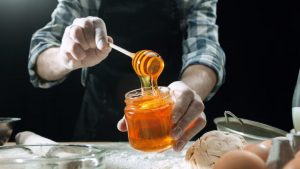Introduction

Honey is not only a sweetener; it’s a golden concoction that has been appreciated since antiquity. It is a creation of the alchemy of nature, made by bees from blossom nectar. Although this fundamental procedure is the same for all it, the diversity and intricacy of honey varieties worldwide are remarkable. Every variety of it has a distinct flavor profile, aroma, and even health advantages, which makes it an intriguing topic for foodies, health enthusiasts, and inquisitive minds to learn more about.
The Basics of Honey Production

It’s important to comprehend the fundamentals of honey production before exploring the wide universe of honey varieties. Honeybees gather nectar from blooming plants and use enzymatic activity and regurgitation to convert it into it. After then, this liquid gold is kept in honeycombs to mature and become the thick, viscous material that we are familiar with.
Floral Varieties: From Acacia to Orange Blossom

The kind of flower that bees collect nectar from is one of the main variables that affects the properties of it . The honey produced by different flower sources has unique smells and scents. For example, orange blossom it emits a zesty scent with a hint of flowery zest, and acacia it is prized for its light color and delicate, gentle taste. Investigating these flower types reveals a diversity of flavors and provides access to local specialties and distinctive dining experiences.https://avengers.wmomiti.com/wp-admin/post.php?post=3052&action=edit
Monofloral vs. Polyfloral Honeys

it are divided into two categories: polyfloral it, which are made primarily from the nectar of several types of flowers, and monofloral it, which are made mostly from the nectar of one type of flower. Manuka honey from New Zealand and lavender it from France are examples of monofloral it. These honeys are highly valued for their unique flavors and can fetch higher prices because of their unique floral provenance. Alternatively, the variety of flavors that polyfloral honeys offer varies according to the place and time of year that they are gathered.
The Influence of Terroir

it can display its terroir, or the unique soil, climate, vegetation, and surroundings of its origin, just like wine can. This effect may be rather strong, changing the honey’s texture, color, taste, and scent in addition. A fresh, herbal it is produced by alpine meadows, and darker, richer honeys with earthy and tree sap notes can be obtained from wooded locations. A deeper appreciation for the natural elements that influence each batch of it is added when one understands terroir.
Health Benefits and Nutritional Value

it has long been prized for its potential health advantages, even outside of its gastronomic appeal. Enzymes, antioxidants, and trace levels of vitamins and minerals can all be found in raw, unprocessed it. Manuka it is known for its antibacterial qualities, while Buckwheat it is recommended for its possible ability to relieve sore throats. To optimize the nutritional content of it, it is usually advised to consume it raw or with minimum processing, as boiling might destroy some of its beneficial ingredients.
Sustainability and Ethical Considerations

Because it is so popular, people are becoming more concerned about ethical and sustainable beekeeping methods. Due to habitat loss, pesticide use, and climate change, bee populations around the world are in danger. As such, it is critical that consumers support beekeepers that put the health of their colonies and the surrounding ecology first. Selecting honey that is sustainably sourced or certified organic guarantees that beekeepers follow regulations that support environmental stewardship and bee health.
Conclusion
In summary, it comes in a variety of delightful forms. Each variety of honey delivers a distinct sensory experience influenced by its floral source, geography, and processing techniques, ranging from the delicate sweetness of Acacia it to the powerful tastes of Buckwheat honey. Investigating various honey varieties not only improves cooking activities but also cultivates a respect for the environment and the complex procedures involved in making this classic confection. Tasted great on toast, even better drizzled over yogurt, and used in baking and cooking, it is still a mainstay in kitchens all over the world, loved for its taste, adaptability, and possible health advantages. Thus, the next time you grab a jar of it, remember its journey from bloom to hive to your table and enjoy it.